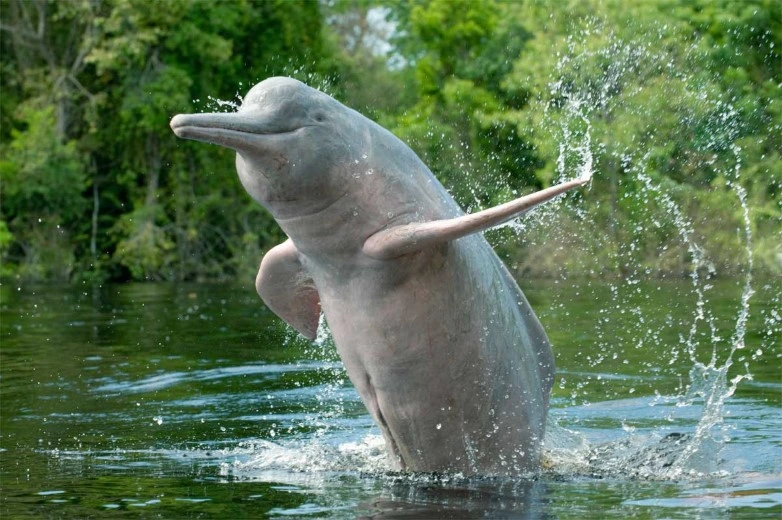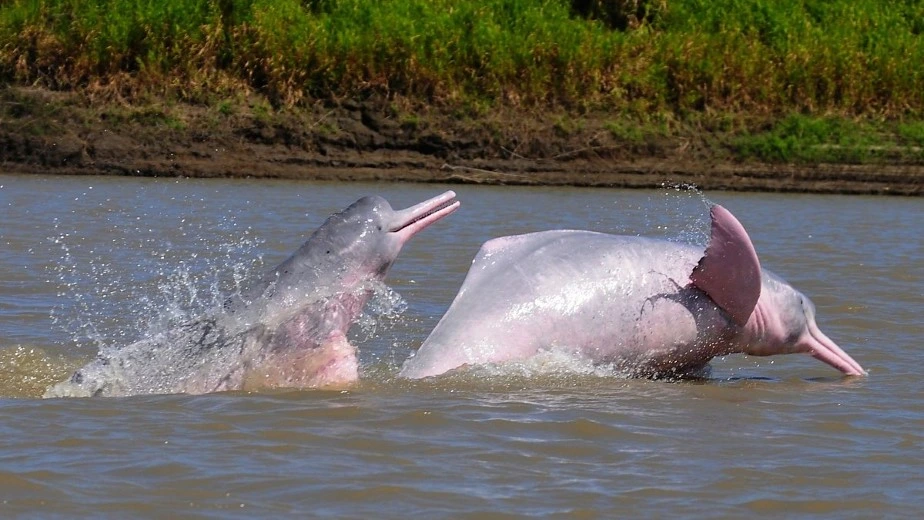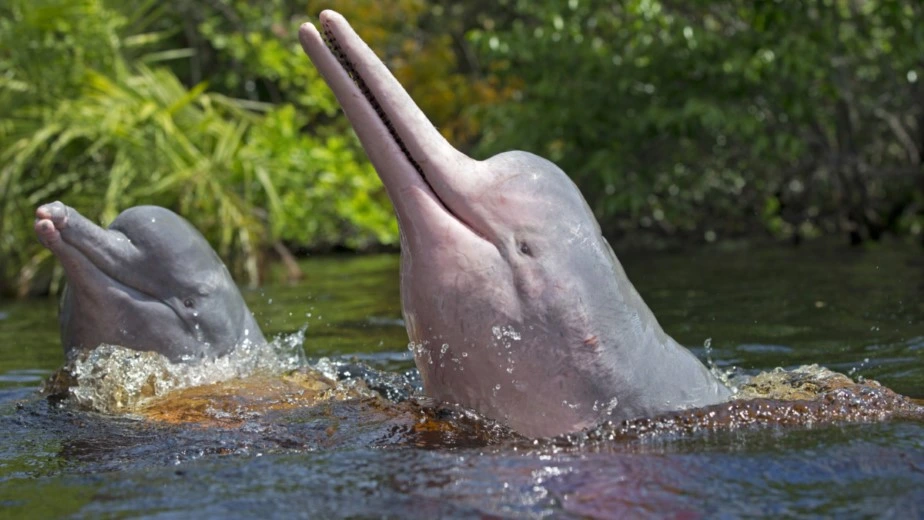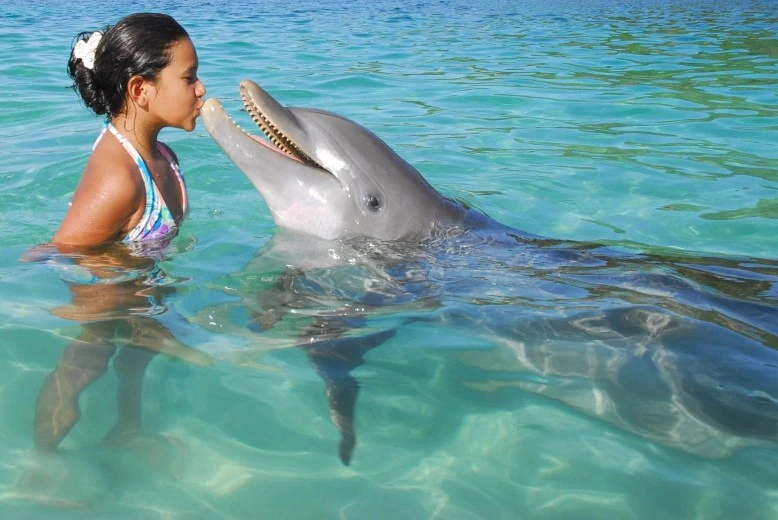The pink river dolphin of the Amazon, also known as the “boto” or “Amazon river dolphin,” is one of the most fascinating and mysterious creatures in nature. With its pink color and friendly behavior, this freshwater dolphin has captured the attention of scientists, tourists, and local communities. Below, we’ll tell you everything you need to know about this incredible animal: from its physical characteristics to its ecological importance, and how you can see it in its natural habitat.
What is the Pink River Dolphin of the Amazon?
The pink river dolphin of the Amazon (Inia geoffrensis) is a species of freshwater dolphin that inhabits the rivers and lakes of the Amazon Basin. It is known for its pink color, which can range from a light shade to an intense pink, especially in adult males. Unlike marine dolphins, the pink river dolphin has unique adaptations that allow it to live in freshwater and navigate through the flooded trees of the rainforest.

Characteristics of the Pink River Dolphin of the Amazon
1. What does the pink river dolphin look like?
The pink river dolphin of the Amazon is easily recognizable by its unique color and flexible body. It can measure between 2 and 2.5 meters in length and weigh up to 180 kg. It has a long, slender snout, small eyes, and a low, elongated dorsal fin. Its pink color is due to blood vessels near the skin, which become more visible when the animal is active or excited.
2. Why is the pink river dolphin pink?
The pink color of the dolphin is not present from birth. Baby dolphins are gray, but as they grow, their skin turns pink. This is due to blood vessels near the surface of their skin, which become more visible over time. Additionally, their diet rich in crustaceans like crabs and shrimp also influences their pink tone. Males are usually pinker than females, especially during mating season.
3. Color changes in the pink river dolphin
Interestingly, the color of the pink river dolphin can change depending on its mood or activity. For example, when they are excited or swimming fast, their skin becomes pinker due to increased blood flow.

Habitat of the Pink River Dolphin
Where does the pink river dolphin live?
The pink river dolphin of the Amazon inhabits rivers, lakes, and channels of the Amazon Basin, which spans countries like Peru, Brazil, Colombia, Bolivia, and Ecuador. It prefers calm and shallow waters, where it can easily find food.
Adaptations to freshwater
Unlike marine dolphins, the pink river dolphin of the Amazon has a flexible neck that allows it to move its head in all directions. This is useful for navigating through the trees and roots of the flooded forest. Additionally, its body is more robust, and its fins are larger, which helps it move in waters with strong currents.

Behavior and Diet
Diet of the pink river dolphin
The pink river dolphin of the Amazon is a carnivorous animal that feeds mainly on fish, crustaceans, and small aquatic animals. It uses its long snout to search for food at the bottom of the river and among tree roots.
Behavior of the pink river dolphin
It is a curious and friendly animal, known for interacting with humans. It is often seen jumping out of the water and playing with other dolphins. However, it is also a skilled hunter and can be very fast when chasing its prey.

Ecological Importance of the Pink River Dolphin
Why is the pink river dolphin important?
The pink river dolphin of the Amazon plays a crucial role in the Amazon ecosystem. As a predator, it helps control fish populations and maintains balance in the food chain. Additionally, it is an indicator of river health: if the dolphins are healthy, it means the ecosystem is healthy too.
Threats and conservation
Unfortunately, the pink river dolphin of the Amazon faces several threats, such as river pollution, illegal fishing, and habitat destruction. Organizations like WWF and Amazon Conservation work to protect this species and its environment.
Legends and Myths about the Pink River Dolphin of the Amazon
In Amazonian culture, the pink river dolphin is the protagonist of many legends. Some communities believe that the dolphin can transform into a handsome man to seduce women. Other stories say that it is a protector of rivers and animals. These legends reflect the deep connection between the pink river dolphin and indigenous communities.

Best Places to Spot Pink River Dolphins
Where to see pink river dolphins in the Amazon?. If you want to see pink river dolphins of the Amazon in their natural habitat, you can visit places like:
- Peru: The Pacaya-Samiria National Reserve, Iquitos, and the Tahuayo River are among the best places to spot pink river dolphins.
- Brazil: The Anavilhanas National Park, near Manaus, is famous for its dolphin populations.
- Colombia: The Amazon River in Leticia offers unique opportunities to see pink river dolphins.
Is it possible to swim with pink river dolphins?
In some places, it is possible to swim near pink river dolphins, but always under the supervision of expert guides. It is important to respect their space and not interfere with their natural behavior.
Fun Facts about the Pink River Dolphin
- The pink river dolphin of the Amazon is one of the few freshwater dolphins in the world.
- It can change color depending on its mood or activity.
- It is considered one of the most intelligent animals in the Amazon.
- Pink river dolphins can live up to 30 years in the wild.
Frequently Asked Questions about the Pink River Dolphin of the Amazon

1. Where can you see pink river dolphins in the Amazon?
The best places include the Pacaya-Samiria National Reserve (Peru), the Mamirauá Reserve (Brazil), and Amacayacu National Park (Colombia).
2. Why does the pink river dolphin change color?
Its pink color is due to blood circulation and tissue regeneration over time. It can also intensify due to water temperature and physical activity.
3. Is it possible to swim with pink river dolphins?
Yes, in some tourist areas it is allowed to swim with them under supervision, but it is important to respect their natural space.
4. What do local communities do to protect them?
Some communities promote ecotourism and environmental education to protect this unique species.
5. Is the pink river dolphin endangered?
Yes, the pink river dolphin of the Amazon is classified as a vulnerable species due to the threats it faces in its habitat.
6. What is the best time to see pink river dolphins in the Amazon?
The ideal season to spot pink river dolphins is during the dry season (June to November), when the rivers have less water and the dolphins are more visible.
The pink river dolphin is a unique and fascinating species that represents the beauty and diversity of the Amazon rainforest. From its pink color to its role in the ecosystem, this dolphin is a true natural treasure. If you have the opportunity to visit the Amazon, don’t miss the chance to see this incredible animal in its natural habitat. Remember: protecting the pink river dolphin of the Amazon is protecting the future of the Amazon.
Tours you might be interested in:

